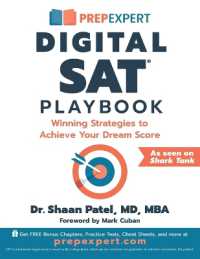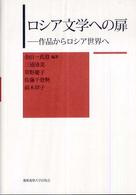- ホーム
- > 洋書
- > 英文書
- > Family / Marriage
Full Description
We live in an increasingly pharmacological and medical world, in which children and adults frequently encounter alleged treatments for an enormous range of illnesses. How do we come to understand what heals and why? Here, 15 studies explore how 1,414 children (ages 5-11) and 882 adults construe the efficacies of different kinds of cures. Developmental patterns in folk physics, folk psychology, and folk biology lead to predictions about which expectations about illnesses and cures will remain relatively constant across development and which expectations will undergo change. With respect to a constant framework, we find that even young school children distinguish between physical and psychological disorders and the treatments that would be most effective for those disorders. In contrast, younger children reason differently about temporal properties associated with cures. They often judge that dramatic departures from prescribed schedules will continue to be effective. They are also less likely than older ages to differentiate between the treatment needs of acute versus chronic disorders, which in turn reflect different intuitions about how medicines work. Younger children see medicines as agent-like entities that migrate only to afflicted regions while having "cure-all" properties, views that help explain their difficulties grasping side effects. They also differ from older children and adults by judging pain and effort as reducing, instead of enhancing, a treatment's power. Finally, across all studies, optimism about treatment efficacy declines with age. Taken together, these studies show major developmental changes in how children envision the ways medicines and other cures work in the body. These findings reveal new dimensions of folk biology and its links to broader patterns in cognitive development. They also carry strong implications for how medicines should be provided and explained to children, as well as for what kinds of medication myths might persevere even in adults.
Contents
CONTENTS
I. INTRODUCTION: UNDERSTANDING MEDICINES AND MEDICAL INTERVENTIONS...7
Kristi L. Lockhart and Frank C. Keil
II. THE PROPER REALMS OF MEDICINES AND THEIR ALTERNATIVES: WHAT COUNT AS CURES?...33
Kristi L. Lockhart and Frank C. Keil
III. TIME COURSES OF ILLNESSES AND TREATMENTS...63
Kristi L. Lockhart and Frank C. Keil
IV. AGENCY AND SPATIAL PATTERNS OF ILLNESSES AND TREATMENTS...83
Kristi L. Lockhart and Frank C. Keil
V. REASONING ABOUT SIDE EFFECTS: INFLUENCES OF TEMPORAL AND SPATIAL EXPECTATIONS...100
Kristi L. Lockhart and Frank C. Keil
VI. TREATMENTS AND TRADEOFFS...123
Kristi L. Lockhart and Frank C. Keil
VII. FOLK MEDICINE AND FOLK CURES...140
Kristi L. Lockhart and Frank C. Keil
REFERENCES...159
ACKNOWLEDGMENTS...174
COMMENTARY
COMMENTARY: WHAT HEALS AND WHY? CHILDREN'S UNDERSTANDING OF MEDICAL TREATMENTS...175
Karl S. Rosengren, Matthew J. Jiang, Charles W. Kalish, David Menendez, and Iseli G. Hernandez
CONTRIBUTORS...184
SUBJECT INDEX...186








